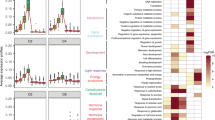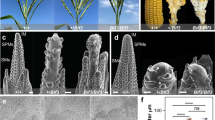Abstract
The domestication of crop plants has often involved an increase in apical dominance (the concentration of resources in the main stem of the plant and a corresponding suppression of axillary branches)1. A striking example of this phenomenon is seen in maize (Zea mays spp. mays), which exhibits a profound increase in apical dominance compared with its probable wild ancestor, teosinte (Zea mays ssp. parviglumis)2. Previous research has identified the teosinte branched1 (tb1) gene as a major contributor to this evolutionary change in maize3. We have cloned tb1 by transposon tagging and show here that it encodes a protein with homology to the cycloidea gene of snapdragon4. The pattern of tb1 expression and the morphology of tb1 mutant plants suggest that tb1 acts both to repress the growth of axillary organs and to enable the formation of female inflorescences. The maize allele of tb1 is expressed at twice the level of the teosinte allele, suggesting that gene regulatory changes underlie the evolutionary divergence of maize from teosinte.
This is a preview of subscription content, access via your institution
Access options
Subscribe to this journal
Receive 51 print issues and online access
$199.00 per year
only $3.90 per issue
Buy this article
- Purchase on Springer Link
- Instant access to full article PDF
Prices may be subject to local taxes which are calculated during checkout
Similar content being viewed by others
References
Harlan, J. R. Crops and Man (Amer. Soc. Agron., Madison, WI, 1992).
Iltis, H. H. From teosinte to maize: the catastrophic sexual transmutation. Science 222, 886–894 (1983).
Doebley, J., Stec, A. & Gustus, C. Teosinte branchedl and the origin of maize: evidence for epistasis and the evolution of dominance. Genetics 141, 333–346 (1995).
Luo, D. et al. Origin of floral asymmetry in Antirrhinum. Nature 383, 794–799 (1996).
Doebley, J. & Stec, A. Inheritance of the morphological differences between maize and teosinte: comparison of results for two F2 populations. Genetics 134, 559–570 (1993).
Burnham, C. Teosinte branched. Maize Genet. Coop. Newslett. 33, 74 (1959).
Schnable, P. tb may condition a semi-dominant effect on tiller number. Maize Genet. Coop. Newslett. 66, 5 (1992).
Woodman, J. C. & Kremer, D. A. in Plant Genetics (ed. Freeling, M.) 834–836 (Liss, NY, 1985).
Chandler, V. L. & Hardeman, K. J. The Mu elements of Zea mays Adv. Genet. 30, 77–122 (1992).
Briggs, S. & Beavis, W. in The Maize Handbook (eds Freeling, M. & Walbot, V.) 653–659 (Springer, New York, 1993).
Coen, E. S. & Meyerowitz, E. M. War of the whorls: genetic interactions controlling flower development. Nature 353, 31–37 (1991).
Paterson, A. et al. Convergent domestication of cereal crops by independent mutations at corresponding genetic loci. Science 269, 1714–1718 (1995).
Sambrook, J., Fritsch, E. M. & Maniatis, T. Molecular Cloning: a Laboratory Manual (Cold Spring Harbor Laboratory Press, New York, 1989).
Christiansen, A. H. & Quail, P. H. Sequence analysis and transcriptional regulation by heat shock of polyubiquitin transcripts from maize. Plant Mol. Biol. 12, 619–632 (1989).
Author information
Authors and Affiliations
Rights and permissions
About this article
Cite this article
Doebley, J., Stec, A. & Hubbard, L. The evolution of apical dominance in maize. Nature 386, 485–488 (1997). https://doi.org/10.1038/386485a0
Received:
Accepted:
Issue Date:
DOI: https://doi.org/10.1038/386485a0
This article is cited by
-
Sweet cherry TCP gene family analysis reveals potential functions of PavTCP1, PavTCP2 and PavTCP3 in fruit light responses
BMC Genomics (2024)
-
Genome-wide identification and integrated analysis of TCP genes controlling ginsenoside biosynthesis in Panax ginseng
BMC Plant Biology (2024)
-
Cytoplasmic genome contributions to domestication and improvement of modern maize
BMC Biology (2024)
-
Profiling the selected hotspots for ear traits in two maize–teosinte populations
Theoretical and Applied Genetics (2024)
-
Genetic and functional mechanisms of yield-related genes in rice
Acta Physiologiae Plantarum (2024)
Comments
By submitting a comment you agree to abide by our Terms and Community Guidelines. If you find something abusive or that does not comply with our terms or guidelines please flag it as inappropriate.



